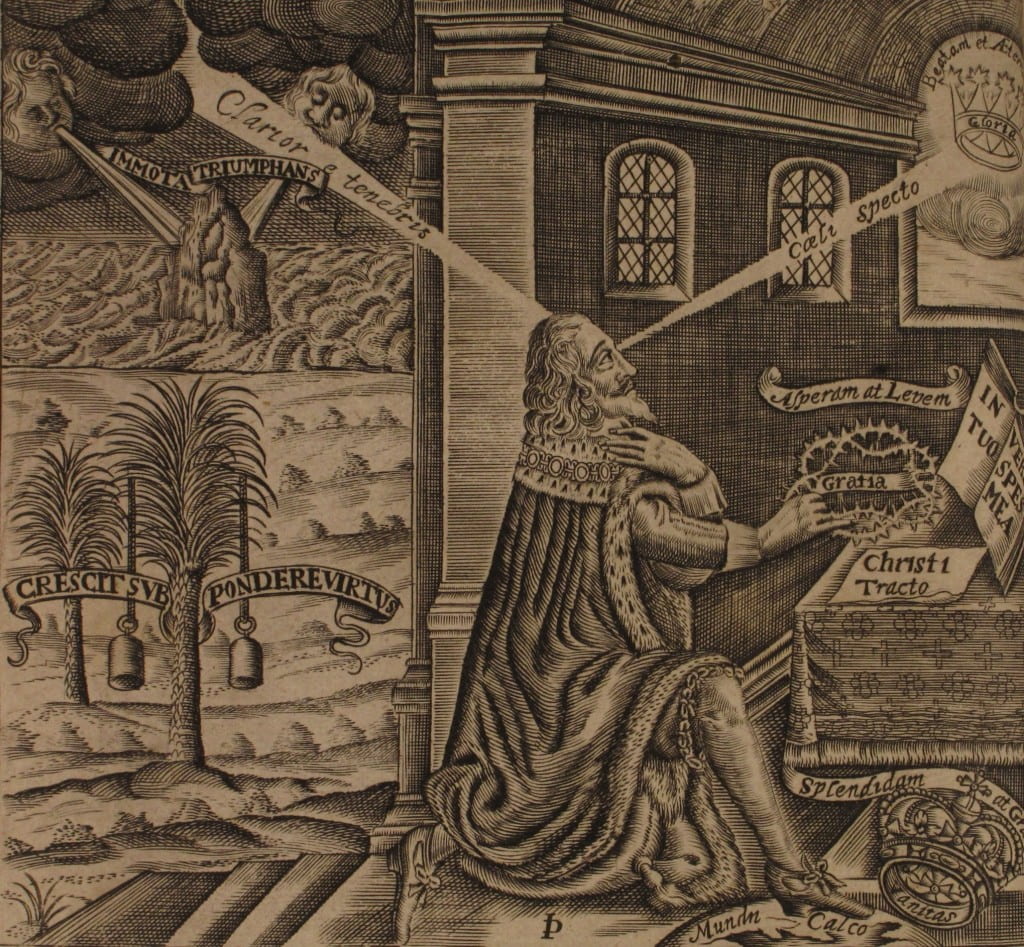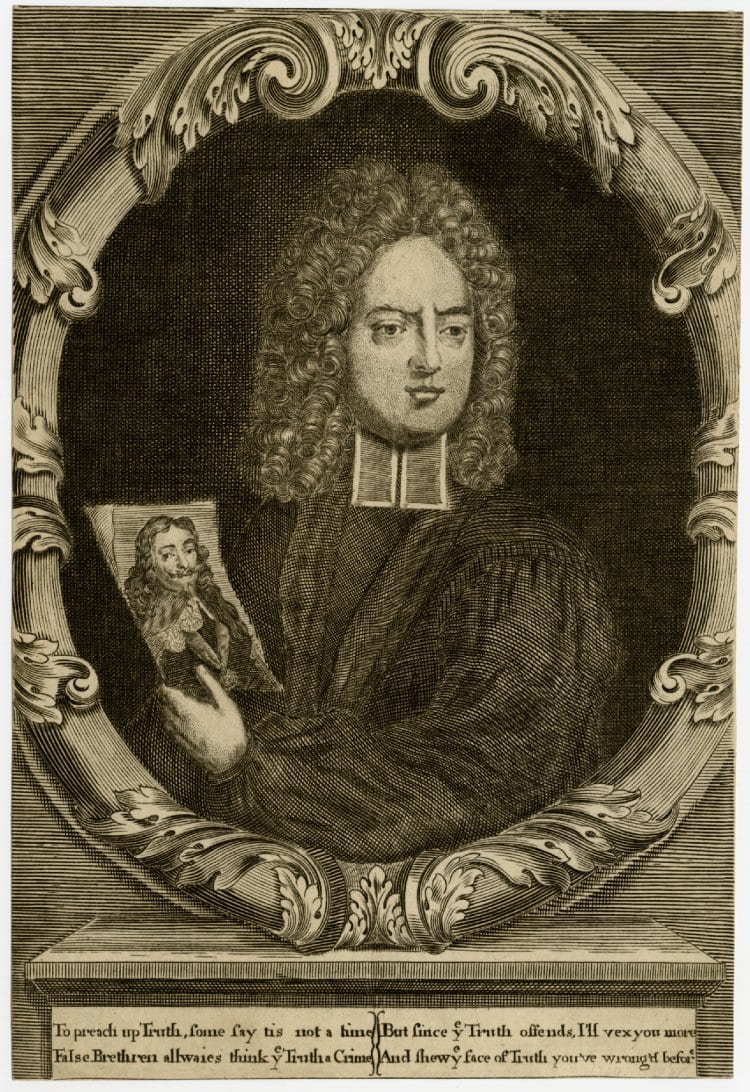by guest contributor Peter Walker
On the cold afternoon of January 30, 1649, King Charles I was publicly beheaded in London, condemned as a traitor by parliamentarians. Royalists, who viewed the king as head of the church, immediately began celebrating the executed King as a martyr. Three hundred and sixty eight years later, this devotional cult remains alive and well, flourishing in unexpected places. This year, the American Society of King Charles the Martyr met for a church service commemorating “Martyrdom Day” at St. Clement’s Church in Philadelphia, a dozen blocks from Independence Hall.
What is the appeal of a royalist devotional cult in the twenty-first-century United States? The cult of King Charles the Martyr had its beginnings in seventeenth-century conflicts between royalists and parliamentarians, and remains entangled with the political theology of sacred kingship. Politics in the United States have taken some unexpected twists recently, but—whatever else might happen—the American experiment in democracy and republicanism probably won’t end with a return to monarchy. Of course, Americans retain an appetite for royalty, as Hello! magazine attests, but Charles I is hardly a celebrity. According to Mark Kishlansky’s unfortunately-named biography, Charles I: An Abbreviated Life, he remains “the most despised monarch in Britain’s historical memory. Considering that among his predecessors were murderers, rapists, psychotics and the mentally challenged, this is no small distinction.” Yet to his fans, King Charles I was and remains a Christian martyr whose spiritual importance transcends the politics of the seventeenth-century Civil War.

The frontispiece to the ‘Eikon Basilke’ (1649)
Historians tend to disagree about Charles’s reign: was he a victim, a tyrant, or simply incompetent? Whatever the case, once he was deposed he played his part as a martyr with dignity, bravery, and political acumen. On the morning of his execution, he wrote that he would greet the day as “my second wedding day; I would be as trim today as may be, for before tonight I hope to be espoused to my blessed Jesus.” He wore two shirts so that he would not shiver from the cold and appear frightened. Addressing the crowd from the scaffolding, he declared himself “the martyr of the people.” He left a spiritual autobiography titled Eikon Basilke (“The Royal Portrait”), which provided an account and justification of his conduct. Here, Charles explained that he could have saved his life if he had given into the demands of the parliamentarians and abolished the bishops of the Church of England. The historian Andrew Lacey calls the Eikon “the most successful book of the century.” Its heavily symbolic frontispiece was particularly influential, showing Charles exchanging the royal crown for a martyr’s crown. Charles himself thus provided his supporters with the material for his cult.
Charles’s martyrdom was his greatest political success. Widespread uneasiness about this national sin eased the restoration of his son, Charles II, in 1660. In 1662, Charles’s martyrdom was incorporated into the liturgical calendar of the Church of England.

Portrait of Henry Sacheverell holding a portrait of Charles I (1709)
The commemoration of Charles’s execution on January 30 was one of three explicitly political services enjoined by the Book of Common Prayer. On May 29, congregations observed the Restoration of Charles II, and on November 5, the failure of the Gunpowder Plot. The latter, directed against Catholics, has remained popular to this day. Martyrdom Day, by contrast, was politically divisive, and was denounced as idolatrous by reforming Protestants.
Following the expulsion of the Stuart dynasty at the “Glorious Revolution” of 1688-89, Martyrdom Day remained part of the Anglican liturgy but its divisiveness made it a political liability. The festival was popular with high churchmen such as Henry Sacheverell, who feared that the generous toleration given to Protestant Dissenters threatened the safety of both church and state. Nevertheless, the theory of sacred monarchy articulated in the January 30 service, and the close association of Charles’s cult with the exiled Stuart dynasty, clashed with the political imperatives of the new regime. By 1772, when Sir Roger Newdigate defended the Church of England’s “only canonized saint” in the House of Commons, he was met with derisive laughter. Charles’s status as a martyr proved even more divisive in the American colonies. His memory was venerated by loyalist Anglicans during the American Revolution, who found in his patient, steadfast suffering a model for their own behavior during the political crisis. For American Anglicans who supported independence, however, Martyrdom Day was an embarrassment. Following independence, the newly-formed Episcopal Church excised the service from its Book of Common Prayer. In Britain, meanwhile, it remained officially observed until 1858, when the service was removed from the Book of Common Prayer by an Act of Parliament.
Today, the cult of King Charles the Martyr is thoroughly anachronistic, doubly so for its American adherents. The festival is not officially observed in either the UK or the US, and it no longer serves the political uses to which it was put in the seventeenth century. It nevertheless retains supporters among high church Anglicans, Episcopalians, and Anglo-Catholics. The cult was revived by the Oxford Movement, and the Society of King Charles the Martyr was founded in 1894. Part of the cult’s attraction, perhaps, lies in the nostalgic and reactionary appeal of deliberate political anachronism. This appears to have been the case for the Society’s Anglo-Irish founder, the Hon. Mrs. Ermengarda Greville-Nugent. But rather more important is its theological meaning to Anglicans who place a particularly high value on the longevity and perpetuation of the church’s institutions. As the cult’s political utility recedes, it becomes easier to see the theological concerns which have always underpinned it.
Perhaps the greatest part of the cult’s power, from its origins to the present, is not so much the sacred monarchy part as the martyrdom part. Charles provides that rare thing, a specifically Anglican martyr. The Society’s hymns celebrate “Royal Charles, who chose to die / Rather than the Faith deny.” The power of martyrdom lies in this choice: by choosing death, the martyr triumphs over the worst that the world can throw at them. Like shooting the moon in a game of cards, martyrdom turns a weak hand into a trump hand. It is the ultimate weapon of the weak, with the potential to upend structures of social and political power. This tradition is embedded in Christianity, ultimately referring to the model of Christ’s death and resurrection. As Brad Gregory showed in his classic book Salvation at Stake, martyrdom was revived during the Reformation, when the martyr’s willingness to die seemed to indicate that they died for the true faith. However, this claim was progressively undone by the undiminishing capacity of rival versions of Christianity to produce their own martyrs. While martyrdom could no longer be counted on to point the way to religious truth, it continued to demonstrate the irreducible resilience of individual religious belief, marking out the limits of the coercive power of the modern state. For all its deliberate anachronism, then, the cult of King Charles the Martyr might just be an essentially modern form of religious observance.
Peter Walker has a Ph.D. in History from Columbia University. His dissertation is about Anglicanism and martyrdom (among other things).



1 Pingback